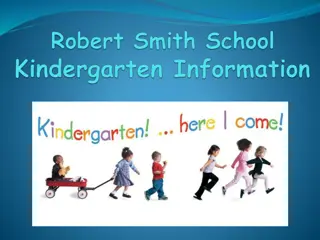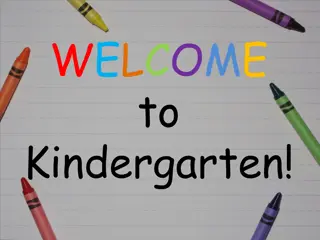Preparing Your Child for Kindergarten: A Guide for Parents
This PowerPoint presentation provides guidance for parents on preparing their child for Kindergarten. It covers various aspects such as learning, thinking, numbers, counting, language development, social-emotional skills, and physical abilities. Tips and activities are shared to help children develop independence, cognitive skills, and social interactions necessary for a successful transition to school. Parent expectations and involvement in the child's education are highlighted as key factors for a smooth start to the school year.
Download Presentation

Please find below an Image/Link to download the presentation.
The content on the website is provided AS IS for your information and personal use only. It may not be sold, licensed, or shared on other websites without obtaining consent from the author. Download presentation by click this link. If you encounter any issues during the download, it is possible that the publisher has removed the file from their server.
E N D
Presentation Transcript
Introduction This year brings many exciting experiences for your child as he/she begins Kindergarten. This powerpoint has been prepared to guide you in ways that you can help your child be ready for this year. We encourage you to read with your child several times a week. Practice opening food items (chip bags, Capri Suns, fruit cups, ketchup packets, etc.) Encourage your child to be independent with personal tasks such as getting dressed and putting away lunch dishes. Encourage your child to make good choices and practice self-control.
Learning and Thinking The student: is willing to complete tasks and try new things. carries on a conversation using complete sentences. states full name, address, phone number, and birthday. shows an interest in books and reading. matches, recognizes, and names at least 5 colors. puts together simple puzzles.
Numbers and Counting The student: identifies numbers 0-10. counts from 1-10 in the correct order. Encourage counting past 10. counts at least 5 objects. identifies basic shapes like circle, square, triangle, and rectangle. identifies two and three dimensional objects.
Language Development The student: carries on a conversation using complete sentences. identifies some letters in random order; including those in their name. names common things-has a good vocabulary. Talk to you child a lot by answering those what s that questions. says or sings familiar songs or nursery rhymes. recognizes when words rhyme, such as cat and hat . follows directions in a simple game with other children or adults.
Social/Emotional The student: takes care of own needs such as toileting, washing hands, and dressing. adjusts to new situations without parent being there. can share toys with other children and is willing to take turns. listens to an adult and follows directions.
Physical The student: holds pencil, marker, crayon correctly. colors carefully by trying to stay in the lines. holds child-sized scissors correctly and has had experience cutting straight and curved lines. practices zipping, buttoning, snapping, and tying.
Parent Expectations Speak positively about school and staff. Communicate with teacher and sign daily folder. Take time each day to talk about the school day. Help with homework. Make sure your child is prepared to come to school with needed items and supplies. Make sure your child gets plenty of rest each night. Make attendance at school a priority. However, please be aware of any symptoms your child might have that would indicate illness. Keep your child home if he/she has a fever.
Parent Suggestions Take time each day to talk to your child. Read with your child daily and talk about the story. Urge your child to recognize the colors. Involve your child in activities and games that require listening and following directions. Teach your child to make various patterns ie. red, blue, red, blue, etc. Support and encourage your child s independence. Encourage work values such as effort, persistence, and initiative. Encourage responsibility by having your child take care of personal belongings and assisting with simple chores.
Other Information Daily Folder Zipper Pouch Label Money in Ziploc bag Tennis Shoes Velcro or slip on Snack Procedure Can bring snack but keep it separate from lunch. Please make sure your child knows which is which. Give your current phone number to your teacher or the school so in case of an emergency, we can reach you. Backpack Seasonal change of clothes Towel for rest time
Back to School Events Tentative Back to School Event: August 5th- 2:00-6:00 pm First Day of School: August 7 Open House: TBD























